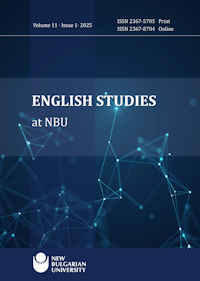Emotional void and identity fragmentation: madness and narcissism in “Lady Audley's Secret” by Mary Elizabeth Braddon (1862).
DOI:
https://doi.org/10.33919/esnbu.25.1.7Keywords:
Bigamy, Braddon, Fake Identity, Lady Audley’s Secret, Madness, Narcissistic PersonalityAbstract
This research aims at investigating the psychological dimension of the protagonist Lady Audley on the grounds of the dialectic of alleged madness and assumed narcissistic personality disorder related to psychoanalytic literary methodology and criticism. In the light of the first Freudian studies of the first decade of the twentieth century and the subsequent outcomes, we attempt the hypothesis of female identity construction onto typically narcissistic features, in the perspective of Freud’s unconscious anticipated by Mary Elizabeth Braddon in her prose generating not only a sensation novel but also an innovative psychological plot depicting the double nature of Victorian society from the perspective of a woman labeled as insane.
References
Alami, S. (2016). Madness in the female character of Mrs Audley in Lady Audley's Secret by Elizabeth Braddon. University of Debrecen.
American Psychiatric Association. (2013). Diagnostic and statistical manual of mental disorders (5th edition). https://doi.org/10.1176/appi.books.9780890425596 DOI: https://doi.org/10.1176/appi.books.9780890425596
Braddon, M, E. 1997. Lady Audley’s Secret. Wordsworth Classics.
Carver, S. (2020). ‘Let them be quiet’: Patriarchy and rebellion in Lady Audley’s Secret. Wordsworth Editions. https://www.academia.edu/61833691
County Asylums. (n.d.). The History of the Asylum. https://www.countyasylums.co.uk/history
Ennis, E. (2012). The Construction of Women from a Gendered Perspective: Pre-Cinematic Victorian Representations and the Male Scopophilic Gaze. MP Journal, 3(5), 82-97.
Eros, M. C. (2010). Ladies’ maids, governesses, and companions: serving women in the great houses of sensation literature. University of Delaware.
Giordano, G. (2021). Lady Audley’s Secret and the portrayal of a criminal mind. Advances in Literary Study, 9(3), 127-134. https://doi.org/10.4236/als.2021.93014 DOI: https://doi.org/10.4236/als.2021.93014
Hatter, J. (2015). Childhood Disrupted: Mary Elizabeth Braddon’s Unfinished Autobiography ‘Before the Knowledge of Evil’. Peer English: the journal of new critical thinking, 10, 11-25. https://hull-repository.worktribe.com/output/379147
Kernberg, O. (1975). Borderline conditions and pathological narcissism. Jason Aronson.
Lee, L. (2011). “Lady Audley’s Secret: How does she do It? Sensation fiction’s technologically minded villainesses”. A companion to sensation fiction. Blackwell Publishing. https://doi.org/10.1002/9781444342239.ch10 DOI: https://doi.org/10.1002/9781444342239.ch10
Lowen, A. (1984). Narcissism: Denial of the true self. Macmillan Publishing.
Naz, B. A. (2016). Victorian murderesses: The politics of female violence. Cambridge Scholars Publishing.
Razumovskaya, O. (2012). Victorian drama in gothic setting ("Lady Audley's Secret" by Mary Elizabeth Braddon). RUDN University.
Downloads
Published
How to Cite
Issue
Section
License
Copyright (c) 2025 Paolo Lantieri

This work is licensed under a Creative Commons Attribution-NonCommercial 4.0 International License.
Access Policy and Content Licensing
All published articles on the ESNBU site are licensed under the Creative Commons Attribution 4.0 International License (CC BY 4.0). This license permits unrestricted use, distribution, and reproduction in any medium, provided the original work is properly cited. It allows reusers to distribute, remix, adapt, and build upon the material in any medium or format, even for commercial purposes. The terms on which the article is published allow the posting of the published article (Version of Record) in any repository by the author(s) or with their consent.
Note that prior to, and including, Volume 10, Issue 2, 2024, articles were licensed under the Non-commercial (CC BY-NC 4.0) license. The transition to CC BY 4.0 is effective as of Volume 11, Issue 1, 2025.
In other words, under the CC BY 4.0 license users are free to
Share — copy and redistribute the material in any medium or format for any purpose, even commercially.
Adapt — remix, transform, and build upon the material for any purpose, even commercially.
Under the following terms:
Attribution (by) - You must give appropriate credit (Title, Author, Source, License), provide a link to the license, and indicate if changes were made. You may do so in any reasonable manner, but not in any way that suggests the licensor endorses you or your use.
No additional restrictions — You may not apply legal terms or technological measures that legally restrict others from doing anything the license permits.
Notice: No warranties are given. The license may not give you all of the permissions necessary for your intended use. For example, other rights such as publicity, privacy, or moral rights may limit how you use the material.
If the law requires that the article be published in the public domain, authors will notify ESNBU at the time of submission, and in such cases the article shall be released under the Creative Commons Public Domain Dedication waiver CC0 1.0 Universal.
Copyright
Copyright for articles published in ESNBU are retained by the authors, with first publication rights granted to the journal. Authors retain full publishing rights and are encouraged to upload their work to institutional repositories, social academic networking sites, etc. ESNBU is not responsible for subsequent uses of the work. It is the author's responsibility to bring an infringement action if so desired by the author.
Exceptions to copyright policy
Occasionally ESNBU may co-publish articles jointly with other publishers, and different licensing conditions may then apply.






